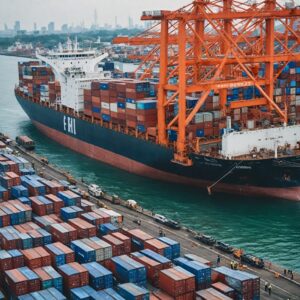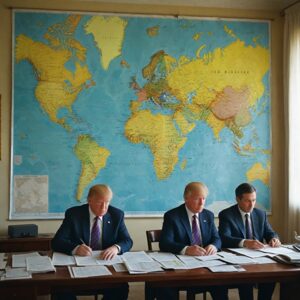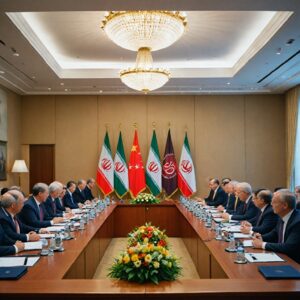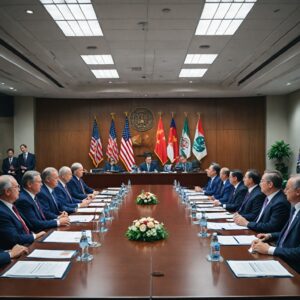Summary
In May 2025, U.S. President Donald Trump announced plans to impose a 50% tariff on imports from the European Union (EU), escalating an already tense trade dispute rooted in his administration’s broader “reciprocal tariff” policy aimed at addressing perceived unfair trade imbalances. The proposed tariffs targeted a wide range of EU goods, including automobiles and industrial products, with the stated objective of compelling the EU to increase its imports of American goods and reduce its trade surplus with the United States. This move came amid stalled trade negotiations and heightened concerns over protectionism, marking one of the most significant transatlantic trade confrontations in recent history.
The announcement triggered immediate and severe reactions in financial markets, with European stock indexes such as the STOXX 600 and Germany’s DAX experiencing sharp declines, while bond yields fell as investors sought safer assets amid growing uncertainty. Key sectors including automotive, banking, and technology suffered notable losses, reflecting worries about disrupted supply chains and increased costs, whereas defensive sectors like utilities gained. The tariff threat also exacerbated fears of a wider trade war, given concurrent retaliatory tariffs from the EU, China, and Canada targeting U.S. exports worth hundreds of billions of dollars.
Economically, the tariffs have been projected to dampen growth and elevate inflationary pressures in both the U.S. and Europe, with analysts forecasting a reduction in U.S. GDP and complex impacts on federal revenues and deficits. The heightened tensions complicated monetary policy outlooks, as central banks grappled with fragile demand and potential inflation fueled by tariffs. Critics of the policy argued that the administration’s approach was based on a flawed understanding of global trade dynamics and risked undermining the integrated transatlantic economy.
Politically and diplomatically, the tariff threat intensified strains between the U.S. and EU, prompting retaliatory measures and diplomatic negotiations led by European Commission President Ursula von der Leyen. The EU’s response included plans for countermeasures and regulatory actions to prevent circumvention of U.S. tariffs, while raising concerns over the unilateral nature of U.S. trade policy and its broader implications for multilateral trade rules and international relations. The dispute highlighted the fragility of global trade cooperation and the potential for economic conflicts to spill over into diplomatic and geopolitical arenas.
Background
In early 2025, tensions in international trade escalated significantly due to the United States government’s imposition of tariffs under President Trump’s so-called “reciprocal tariff” regime. This policy aimed to address perceived unfair trade imbalances by applying tariffs ranging from 10 to 50 percent on imports from nearly all U.S. trading partners, excluding products already subject to specific tariffs such as steel, aluminum, and automobiles. The announcement of these tariffs prompted widespread concern among global markets and trade partners alike, triggering retaliatory measures and market volatility.
The tariff measures were grounded in the administration’s view that trade deficits harm the U.S. economy and must be corrected through unilateral actions. However, economists widely criticized this stance as a flawed understanding of trade dynamics. The immediate consequences included retaliatory tariffs from key U.S. trade partners such as China, Canada, and the European Union, targeting nearly $90 billion of American exports and imposing duties on agricultural and industrial goods. These retaliations intensified fears of a broader trade conflict.
Domestic factors within the United States also played a crucial role in shaping the trade policy direction. The Treasury Department expressed growing alarm over developments in the U.S. Treasury bond market amid escalating trade tensions, which contributed to President Trump’s decision to pause the reciprocal tariff program temporarily in early April 2025. This pause was notable given the administration’s prior firm endorsement of the tariffs and came unexpectedly even during congressional testimony supporting the policy.
The economic significance of EU–U.S. trade relations further complicated the situation. The transatlantic commercial relationship is one of the largest in the world, with bilateral trade in goods and services reaching approximately €1.6 trillion in 2023. The EU is the U.S.’s largest goods export market and the second-largest import source, with a €157 billion trade surplus in goods and a €109 billion deficit in services with the U.S. during the same year. Tariffs on European goods risked disrupting this crucial trade flow and harming both economies.
Historically, trade conflicts such as these have the potential to escalate beyond economic disputes, sometimes contributing to political and military tensions. Past conflicts, including the Anglo-Dutch Wars, were sparked by disputes over trade dominance and tariff policies, illustrating the broader risks involved when trade disagreements intensify. While tariffs are one mechanism among many in trade disputes, their imposition often signals deeper underlying issues related to domestic political pressures and international competitiveness.
In this context, the U.S. tariff announcements in 2025 not only unsettled financial markets—including significant declines in European stock and bond prices—but also underscored the fragility and complexity of modern global trade relations.
The Tariff Warning
In late May 2025, U.S. President Donald Trump issued a stark warning to the European Union (EU), announcing plans to impose tariffs at a rate of 50% on EU imports starting June 1 due to stalled trade negotiations and persistent trade imbalances. This announcement followed a series of escalating tariff measures under Trump’s administration, which had earlier introduced reciprocal tariffs targeting multiple trading partners to address what was described as harmful trade deficits and unfair trade practices. The tariffs aimed to penalize countries perceived to have higher tariffs on U.S. goods, impose non-tariff barriers, or otherwise undermine American economic interests.
Trump’s tariff warning to the EU was part of a broader strategy to coerce the bloc into increasing imports of American products, including cars, agricultural goods, and energy commodities. This followed earlier threats made prior to his second inauguration, highlighting the administration’s emphasis on reducing trade surpluses held by the EU through increased market access for U.S. exports. The announcement also came amid fears that the EU and other trade partners might retaliate with countermeasures, potentially restricting U.S. companies’ access to public procurement and service markets within the EU.
The immediate market reaction to the tariff warning was sharply negative, contributing to a significant downturn in European stock and bond prices. Investors reacted to the heightened uncertainty surrounding transatlantic trade relations and the potential for an intensifying trade conflict. The threatened tariffs were viewed as part of a pattern of increasingly aggressive trade policies under Trump’s reciprocal tariff framework, which had already sparked retaliations from multiple countries and raised concerns about the broader implications for global trade stability.
Despite the administration’s assertion that tariffs were a necessary tool to correct imbalances and protect American industries, many economists and market analysts criticized the approach as based on a flawed understanding of trade dynamics. The tariff warning also underscored the ongoing challenges in U.S.-EU trade negotiations and the potential for escalating economic tensions between two of the world’s largest trading partners.
Immediate Market Reactions
The announcement of President Trump’s 50% tariff threat on the European Union triggered immediate and widespread declines in European stock and bond markets. The pan-European STOXX 600 index dropped by approximately 1.6% shortly after the market opened, with banks falling 3.2% and technology stocks down 2.6%. The Stoxx Autos index experienced a sharper decline of 3.9%, largely due to the imposition of a 25% tariff on imported vehicles to the U.S., compounding existing duties on steel and aluminum. Defensive sectors such as utilities, however, saw gains of nearly 3%, reflecting investor flight to safer assets amid the turmoil.
Country-specific markets showed varied resilience, with the Spanish selective index registering a relatively modest decline of 1.2%, outperforming many of its European counterparts, which averaged a 3% drop. In contrast, France’s CAC 40 suffered a severe weekly loss of about 4.3%, marking some of the largest declines for European shares in years. Germany’s DAX index was particularly hard hit, plunging over 5% in a single day to a low of 20,590 points, and extending its weekly losses to around 8% as heightened volatility gripped the market.
The tariff announcement exacerbated existing market jitters fueled by ongoing trade tensions and policy uncertainty. Investors awaited further details of reciprocal tariffs announced by the White House, which were set to take effect immediately upon announcement, adding to the nervousness in the market. Pharma stocks, for example, became a notable drag on the benchmark index amid this wave of uncertainty.
Bond markets mirrored the equity selloff, with European government bond yields declining as investors sought safety amid the escalating trade conflict. Germany’s two-year bond yield fell by 10 basis points to 1.73%, and 10-year yields dropped by 9 basis points to 2.55% as investors increased bets on European Central Bank easing measures. Meanwhile, U.S. Treasury yields had previously surged in response to tariff hikes on Chinese goods, reflecting investor concerns over inflationary pressures and fiscal deficits.
The broader economic outlook appeared increasingly fragile as the markets digested the implications of the tariff escalation. Analysts noted that private domestic demand in Europe remained weak, casting doubt on the sustainability of current interest rate levels and amplifying calls for central bank intervention. Overall, the immediate market reaction highlighted a sharp divergence between U.S. and European financial conditions and underscored the sensitivity of global markets to geopolitical developments and trade policy shifts.
Economic Impact Analysis
The announcement of Trump’s 50% tariff warning on the European Union (EU) has generated significant market turbulence, notably impacting both European stock and bond prices. The tariffs, combined with retaliatory measures from China, Canada, and the EU itself—targeting approximately $330 billion of U.S. exports—have led to a broad reassessment of economic prospects and risk among investors.
The imposition of these tariffs is projected to reduce U.S. GDP by 0.2% and diminish 10-year federal revenue by $132 billion on a dynamic basis, while simultaneously increasing federal tax revenues by $157.4 billion by 2025. This represents the largest tax hike since 1993, intensifying concerns about inflationary pressures and economic slowdown. The resulting uncertainty has been reflected in stock market fluctuations, with major indexes experiencing volatility as traders weigh the consequences of ongoing trade tensions.
In the bond market, yields on U.S. Treasuries have risen sharply, a reaction driven by fears that tariffs will stoke inflation and increase government deficits. While typically U.S. Treasuries are viewed as safe havens during periods of market stress, the unique macroeconomic factors induced by tariffs—such as heightened inflation risk and expanding deficit spending—have led to a reassessment of their risk and fair value. Furthermore, low demand at recent Treasury auctions amid tariff announcements has exacerbated concerns regarding foreign investor appetite for U.S. government debt.
European financial markets have also borne the brunt of tariff-related uncertainty. According to Bank of America analysts, the euro zone economy faces challenges in sustaining neutral interest rates around 2%, partly due to weak private domestic demand and the added strain from trade tensions. European Commission President Ursula von der Leyen has indicated the EU’s readiness to implement stringent countermeasures, including regulatory measures to limit the redirection of Chinese exports affected by U.S. tariffs into the European market. This further underscores the risk of escalating trade conflicts and prolonged market volatility.
Additionally, the EU recorded a substantial services trade deficit of €109 billion with the U.S. in 2023, highlighting the potential economic ramifications if tariff-induced price increases reduce demand for EU services in the U.S. market. The combination of direct tariff impacts, retaliatory actions, and secondary effects such as higher prices for substitute goods constrains market choices and increases costs for consumers and businesses alike.
Investor sentiment remains fragile amid this environment. While there is some optimism from positive trade communications between the U.S. and China, and continued monitoring of European economic data, the overarching market narrative reflects caution due to the persistent threat of tariff escalation and its inflationary implications. Federal Reserve Chair Jerome Powell has emphasized the need to carefully assess tariff impacts before adjusting monetary policy, warning that premature rate cuts could exacerbate inflationary pressures.
Political and Diplomatic Repercussions
The announcement of President Trump’s imposition of reciprocal tariffs, including rates as high as 50 percent on European Union (EU) imports, sparked significant political and diplomatic tensions between the United States and the EU. The EU responded with a combination of diplomatic engagement and retaliatory measures aimed at protecting its economic interests and asserting its position in global trade disputes.
European Commission President Ursula von der Leyen played a central role in managing the EU’s response. Initially, she expressed a willingness to “give negotiations a chance” by suspending the implementation of retaliatory tariffs for a 90-day period, signaling an openness to dialogue despite the high stakes involved. However, von der Leyen warned that if negotiations proved unsatisfactory, the EU would proceed with a series of countermeasures, which she referred to as the “EU trade bazooka measures,” targeting sectors where the United States held a substantial services surplus with the EU. The EU also indicated plans to prevent the redirection of Chinese exports, impacted by U.S. tariffs, into the European market through regulatory actions.
On the diplomatic front, tensions extended beyond trade disputes to broader concerns about the U.S.’s unilateral approach. The Trump administration’s inclusion of EU taxation and regulation within its reciprocal tariff calculations was viewed by EU officials and trade experts as potentially coercive, complicating negotiations and adding to mistrust. Meanwhile, European leaders emphasized the need for maintaining Europe’s political and economic autonomy, with some cautioning against undue influence from the U.S. administration on European affairs.
The trade conflict also had ramifications within multilateral institutions. China filed official complaints accusing the United States of violating World Trade Organization (WTO) rules amid the escalating tariff exchanges, highlighting the broader international legal and diplomatic dimensions of the dispute. The EU, for its part, prepared to consult on possible countermeasures and readied WTO litigation as a formal response to U.S. tariffs, reinforcing the institutional avenues for conflict resolution outside of bilateral negotiations.
This series of events underscored the complex interplay between domestic political decisions in the U.S. and the international diplomatic landscape, reflecting how trade policy can escalate into multifaceted political and diplomatic confrontations with significant consequences for global economic relations.
Detailed Timeline of Events
In October 2019, the United States imposed tariffs on European Union (EU) goods, initially setting baseline rates at 20%, though some were delayed and reduced to 10% for a 90-day period as part of a temporary suspension agreement. During this period, the EU also suspended its retaliatory tariffs, hoping to reach a negotiated settlement with the U.S.. European Commission President Ursula von der Leyen warned that if talks failed by the end of this window, the EU would deploy what she termed “EU trade bazooka measures,” targeting the substantial U.S. services surplus with the EU.
After the suspension expired, the EU initiated a two-phase retaliation plan against U.S. tariffs, aiming to impose tariffs on €26 billion worth of American imports starting April 1. The first phase reintroduced tariffs on notable American products such as bourbon whiskey—tariffs originally implemented during President Trump’s first term but suspended in 2023 following negotiations with President Biden. The second phase planned additional tariffs on €18 billion of U.S. industrial and agricultural goods.
In response to the EU’s retaliation, President Trump condemned the proposed 50% tariff on American bourbon and threatened to impose tariffs as high as 200% on EU alcoholic products, escalating tensions between the two trading blocs. This back-and-forth contributed to significant market volatility, with European stock and bond prices tumbling in reaction to the tariff warnings and uncertainty over trade negotiations.
Throughout these developments, the U.S. also maintained tariffs under Section 232 on steel and aluminum imports from several trading partners, including Canada, Mexico, and China, prompting ongoing updates to revenue and economic impact estimates by economic analysts and organizations like the Tax Foundation. The evolving tariff landscape generated considerable uncertainty on Wall Street, influencing investor behavior
Sectoral Impact and Notable Companies
The announcement of President Trump’s tariffs, including a universal 10 percent tariff and additional tariffs reaching up to 50 percent on trading partners based on their trade balance with the United States, had a significant impact on various sectors within European stock markets. The automotive sector was notably affected, with the Stoxx Autos index dropping by 3.9% following the imposition of a 25% tariff on imported vehicles to the U.S., which compounded existing duties on steel and aluminum. This decline reflected investor concerns about the increased costs and potential reduction in competitiveness for European automakers in the U.S. market.
The banking and technology sectors also experienced marked declines, falling by 5.6% and 4.5% respectively. The banking sector’s downturn can be partially attributed to tightening credit conditions and a more cautious lending environment in response to the uncertainties created by tariffs and related economic factors. The technology sector faced pressure as tariffs threatened supply chains and raised costs for components, including electrical machinery and equipment—a category heavily represented by exports such as smartphones and lithium-ion batteries, which are of particular concern given their significant export value from China to the U.S..
In contrast, utility stocks, typically considered a defensive investment during periods of market turmoil, rose nearly 3%, as investors sought refuge in more stable sectors amid the volatility triggered by the tariff announcements.
The sectoral impacts underscore the broad reach of the tariffs across industries integral to European exports and the global supply chain. Key companies within these sectors, especially automakers and technology firms heavily involved in U.S. trade, have had to adjust their strategies in response to increased tariffs and retaliatory measures imposed by the European Union and other trading partners. This environment has led to increased scrutiny from fund managers and investors who weigh the sustainability of these tariffs against their potential to reshape trade flows and production patterns globally.

























